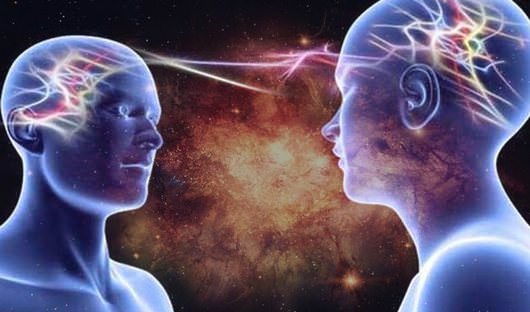
We have all heard stories of people sharing the same dream. Whether it be just sharing aspects of the same dream or having a full blown identical dream, dream sharing fascinates us. The question is, if shared dreaming is possible then surely lucid dreamers should be able to do it.
Contents
Exploring The Theory Of Mutual Dreaming
Many would-be lucid dreamers, and even the more experienced oneironauts, wonder if mutual dreaming (shared dreaming) is possible.
Obviously shared dreams in the unconscious state would be exciting but how much more exhilarating would a shared lucid dream be? In a lucid dream you are fully conscious and aware.
So a shared lucid dream would be so much more powerful an experience than a mere ordinary mutual dream. At least that’s the theory.
But, is it possible to dream with someone else?
The curious cases of mutual dreaming
Mutual dreaming as a real phenomenon is far from proven.
Shared dreams are usually dreams that share similar themes rather than being dreams where 2 or more people dream exactly the same thing in the the same order.

In most cases a mutual dream will occur when 2 or more people have been involved in the same activity and then each person dreams about it that night. Obviously there are psychological reasons for this as we often carry over our daily activities into dreams.
This is not the same as having a shared dream though. The above scenario is a representation of something known as a meshing dream.
However, there are documented cases of people sharing dreams.
Psychologists even recognize this phenomenon though they are at a loss to explain it as there have been no scientific investigations into it.
I suppose the best way to prove or disprove that shared mutual dreaming is possible is to experiment with it and the only people who could really do that consciously and consistently are lucid dreamers.
Before we take a look to see if there is any real evidence for the existence of shared lucid dreaming, we should first look at ancient accounts of dreams and how they relate to shared dreaming.
Why look at ancient accounts? Because the ancients considered dreams to be much more important than modern man does and so documented many of them.
First let’s look at the Bible. The Bible is filled with stories of dreams, as dreaming and dream interpretation was extremely important to the Hebrews.
We see in the Bible that God used dreams frequently to communicate with his people and show them prophetic visions.
In the article, is lucid dreaming biblical I outline the 21 biblical accounts of dreams and show how many of them were lucid in nature.
In that article I also include the biblical passages that foretell of future dreams and that mention dreams as being important without the passages giving us the exact account of the dreams.
If you are a Christian, or belong to a different faith but still get your spiritual beliefs from the Bible, then you may want to read is lucid dreaming a sin and is lucid dreaming evil for more information on how lucid dreaming can affect you spiritually.
Although the Bible is a great source about dreams and lucid dreams it is not the only ancient account. Sumerian tablets from Babylon from about 2700 B.C document the dreams of Babylonian royalty.
It was believed that dreams could be used for divination.
Then we have accounts from ancient Egypt that date back as far as 4000 B.C. Priests would interpret dreams in ancient Egypt and use them to divine the future.
Dreams were very important things in ancient cultures. And, in almost all ancient cultures it was believed that shared dreaming was possible.
But what about in modern times? Can we share a dream with someone else in the 21 Century or are our modern brains completely closed off to the possibility? The answer to that question may lie with lucid dreamers.
Can you lucid dream with someone else?
There is only anecdotal evidence to suggest that you can lucid dream with someone else.
Famous lucid dreamer Stephen LaBerge began conducting research into shared lucid dreaming in 2019 with results still pending.
Although some lucid dreamers believe you can lucid dream with another person there is no solid evidence that it is possible.
So as you can see there is no evidence that shared lucid dreaming is possible, though again there is anecdotal evidence that it happens.
We will have to wait for the famous lucid dreamer Stephen LaBerge to realise his finding on the matter.
If you are a lucid dreamer and you belong to a group of lucid dreamers (like this one) then you could experiment with shared dreaming yourself.
I myself have not tried it and have a completely open mind on the subject.
How to dream with someone else in theory
As lucid dreamers have full control over their dreams and can do anything within their lucid dreams it should come as no surprise that experiments into shared dreaming have been undertaken.
Stephen LaBerge, in his Facebook group, has been conducting experiments into shared lucid dreaming for a few years.
Unfortunately, he has not realized any data on his findings.
As there is no real data, or even accounts from lucid dreamers, about whether shared lucid dreams are possible I must use my own experiences and those of other lucid dreamers whom I have talked to about it, in order to breach this subject matter effectively.

From my own perspective I have never had a shared lucid dream with another lucid dreamer. Nor do I have any evidence that I have shared a lucid dream with a non-lucid dreamer.
Now, I have had a few lucid dreams in which a person has acted completely independently of my intentions and been so true to real life that I had to ask the person the next day if they remembered their dream and if I was in it.
Unfortunately, I have yet to have this kind of lucid dream and have the person involved remember it in a similar way (or even remember it at all or remember me being in it).
Any experiments I have conducted with other lucid dreamers have failed to provide any evidence of shared dreaming.
In all cases, although we both dreamed a similar dream (because we pre-programmed it) and we were both in each other’s dream, the dreams did not line-up.
Upon comparing our lucid dream experiences it became obvious we had different dreams and were only interacting with dream characters, representations of the other person, and the person themselves.
Other lucid dreamers claim to have fared much better, though these are only personal accounts shared on Reddit and Quora.
I blame Inception for making people believe you can enter another person’s dream
The ability to join someone else’s dream is a skill some people call dream walking.
Does it exist?
Some people believe it does. However, I am skeptical for lots of reasons, most of which I give below.
Unfortunately, there is only anecdotal evidence for shared dreaming and almost none for shared lucid dreaming. Why is this?
I outline below the main reasons why some people appear to share a regular dream – when in fact they do not.
When you watch the video below you will see how easy it is for us to become mentally programmed during the day to think in a specific way.
In the same way we can be influenced to act in a specific way during the day we can also be influenced to dream in a certain way.
Shared experiences during the day can lead to two or more people having dreams with similar imagery and themes.
However, they are not sharing the same dream. This will become easier to understand as you progress through this article.
It is my belief that if shared dreaming were possible then lucid dreamers would have proven it by now.
Because the dreamer is fully conscious in a lucid dream, and can guide and alter the dream as they see fit, a lucid dreamer is in a perfect position to prove shred dreaming.
If mutual shared dreaming were possible then to prove it was a real phenomenon all that would be needed is for 2 or more lucid dreamers to agree upon meeting in a lucid dream and then later compare notes.
If the compared experiences match in every respect then this would be pretty good proof that shared dreaming is possible.
I have never had an experience of this and have yet to find anyone else who has. Any experiments that I have been party to have always failed miserably.
However, Stephen LaBerge continues to experiment with this and I look forward to him sharing his findings.
As he has been doing this for some years, and has yet to comment on shared dreaming being a real thing I can only assume that he either has no evidence for it and his experiments have failed.
This is my personal belief only however. It could be that he is sitting on his findings waiting to make a monumental statement about how real shared dreaming really is (I doubt it though).
As I have clearly demonstrated throughout this website lucid dreams feel exceptionally real but they are not real. Lucid Dreams are the same as regular dreams with 2 exceptions; 1. you are fully conscious in the dream; 2. you can control the dream.
Lucid dreams occur in the mind of the dreamer. Therefore they happen in an isolated environment.
Lucid dreams are no different in structure than regular normal dreams. Although the causes for lucid dreams differ from regular dreams, they are both still dreams.

They both still only happen within your own mind.
The reason why some people believe that shared lucid dreaming is possible is that lucid dreams tend to feel so real that they are difficult to distinguish from reality.
In lucid dreams some people you meet have such individualistic personalities and the places you visit appear to be so detailed and real that it is easy to believe you are in a real place and meeting real people. But, rest assured, you are most definitely not!
You Can Meet Someone In A Lucid Dream But Not In The Way You Think
As I pointed out in the article can you visit someone in a lucid dream it is possible to spend time with anyone you want to spend time with while you are lucid dreaming. But these people are not real life individuals – no matter how real and distinctive they seem.
You can meet anyone in a lucid dream but it will not be the real person.
Although the person will look, sound and feel real, and may even display individualistic characteristics they are only a subconscious representation within your mind.
There is no evidence to suggest you can meet a real person in a lucid dream even after many experiments.
In the aforementioned article I give an example of how one lucid dreamer believed that the guy in is lucid dream must be real due to how he acted and reacted within the ream.
But I clearly demonstrate in that article how that dream character could not have been real and was in fact just a representation of the dreamer’s own subconscious mind (or at least a small aspect of it). I outline clear evidence to support this view.
However, there are accounts of lucid dreamers who claim that they can visit other people in their lucid dreams.
In one such account given by lucid dreamer Mark Jessup he claims that people get freaked out when he relates what he saw them doing.
I will certainly not dispute his account nor call into question his honesty but I would need many lucid dreamers to come forward with similar stories before I accepted this as commonplace, or even reality.
If there are lucid dreamers out there with stories of shared lucid dreams or of times when they definitely met someone else in a dream I would love to hear from you.
It is possible to share a similar dream experience without actually sharing the same dream.
To illustrate how this is possible we will look at a trick that a famous English mentalist, called Derren Brown, used to influence two advertising executives.
In the video below you will see how Derren Brown used clever subliminal tactics to influence the executives to create a marketing poster that contained images and slogans that Brown had unconsciously given to them.
Why use a mentalist’s trick to demonstrate how we can share similar dreams without being in the same dream? Well, it’s all about how the mind is influenced.
Watch the video below and then I will show you how this relates to shared dreaming.
We see that through subliminal programming Derren Brown was able to unconsciously persuade the advertising executives to create the exact advertisement that Brown had designed.
The exes poster had similar images and slogans as Brown’s even though they had never consciously seen it. They thought it was all their idea.
So what does this have to do with shared dreaming?
We are bombarded by subliminal stimuli all day. This stimuli can easily seep into our dreams and influence the structure, feel and narrative of our dreams.
Even things that happen to us when we are fully conscious can make their way into our dreams.
So, two people who have shared a similar experience during the day may find that similar images and themes appear in their dreams that night.
This is perfectly normal and much more common than you may think.
Of course it only happens very occasionally that we share our dream experience with someone else.
So, there is therefore much less opportunities to notice how often this shared dream imagery occurs.
Most times when we decide to tell someone else about a particular dream we had, it is because something important or weird happened in the dream that is very personal to us.
There is therefore less chance of us sharing the type of dream that would have similarities with the listener’s dream.
In addition, no-one talks about these dreams online.
It is only on the occasion that dreams seem to be similar that we get freaked out by them and place more meaning on the experience than it warrants.
What’s more most people do not remember their dreams in detail.
It is therefore easy to get carried away by the narrative of a friend or relative who shared a similar dream and convince yourself that the two dreams were closer in structure and narrative than they really were – this happens unconsciously as is completely normal.
The fact that lucid dreamers cannot regularly prove the existence of shared dreams tends to reinforce the belief that they do not exist.
As lucid dreamers are fully conscious with in a lucid dream they are free to test the theory if the person they are interacting with is real or just a dream representation and 2 or more lucid dreamers can agree to meet in a shared dream.
Yet, this has yet to happen.
There has yet to be any hard evidence that shared lucid dreaming is possible thus making it extremely unlikely to exist.
Therefore we can assume that because shared lucid dreaming is unlikely to exist, shared regular dreaming is also unlikely to exist.
